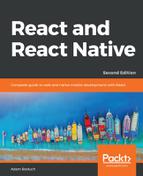In this chapter, you learned a lot about the lifecycle of React components. We started things off with a discussion on why React components need a lifecycle in the first place. It turns out that React can't do everything automatically for us, so we need to write some code that's run at the appropriate time during the components' lifecycles.
Next, you implemented several components that were able to fetch their initial data and initialize their state from JSX properties. Then, you learned how to implement more efficient React components by providing a shouldComponentRender() method.
You learned how to hide the imperative code that some components need to implement and how to clean up after asynchronous behavior. Finally, you learned how to use the new error boundary functionality from React 16.
In the following chapter, you'll learn techniques that help to ensure that your components are being passed the right properties.
